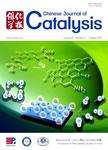Mechanism and active sites of CO oxidation over single-crystal Au surfaces and a Au/TiO_2(110) model surface
单晶Au表面和Au/TiO_2(110)模型催化剂表面CO氧化反应机理和活性位(英文)作者机构:日本国立产业技术综合研究所
出 版 物:《Chinese Journal of Catalysis》 (催化学报(英文))
年 卷 期:2016年第37卷第10期
页 面:1676-1683页
核心收录:
学科分类:081705[工学-工业催化] 08[工学] 0817[工学-化学工程与技术]
基 金:financially supported by JST-CREST
主 题:Gold Model catalyst CO oxidation Reaction mechanism Active sites
摘 要:We describe the reaction mechanism and active sites for CO oxidation over a Au/TiO2(110) model surface and Au single‐crystal surfaces, along with the role of H2O, on a molecular scale. At low tem‐perature (<320 K), H2O played an essential role in promoting CO oxidation, and the active site for CO oxidation was the perimeter of the interface between the gold nanoparticles and the TiO2 sup‐port (Auδ+–Oδ––Ti). We believe that the O–O bond was activated by the formation of OOH, which was produced directly from O2 and H2O at the perimeter of the interface between the gold nanoparticles and the TiO2 support, and consequently OOH reacted with CO to form CO2. This reaction mechanism explains the dependence of the CO2 formation rate on O2 pressure at 300 K. In contrast, at high temperature (>320 K), low‐coordinated gold atoms built up on the surface as a result of surface reconstruction due to exposure to CO. The low‐coordinated gold atoms adsorbed O2, which then dissociated and oxidized CO on the metallic gold surface.



